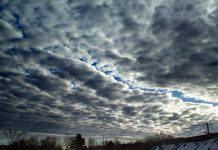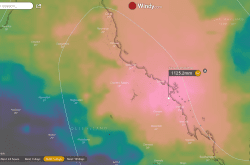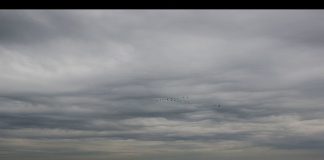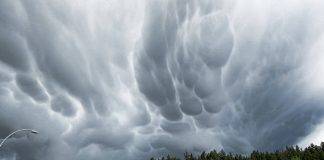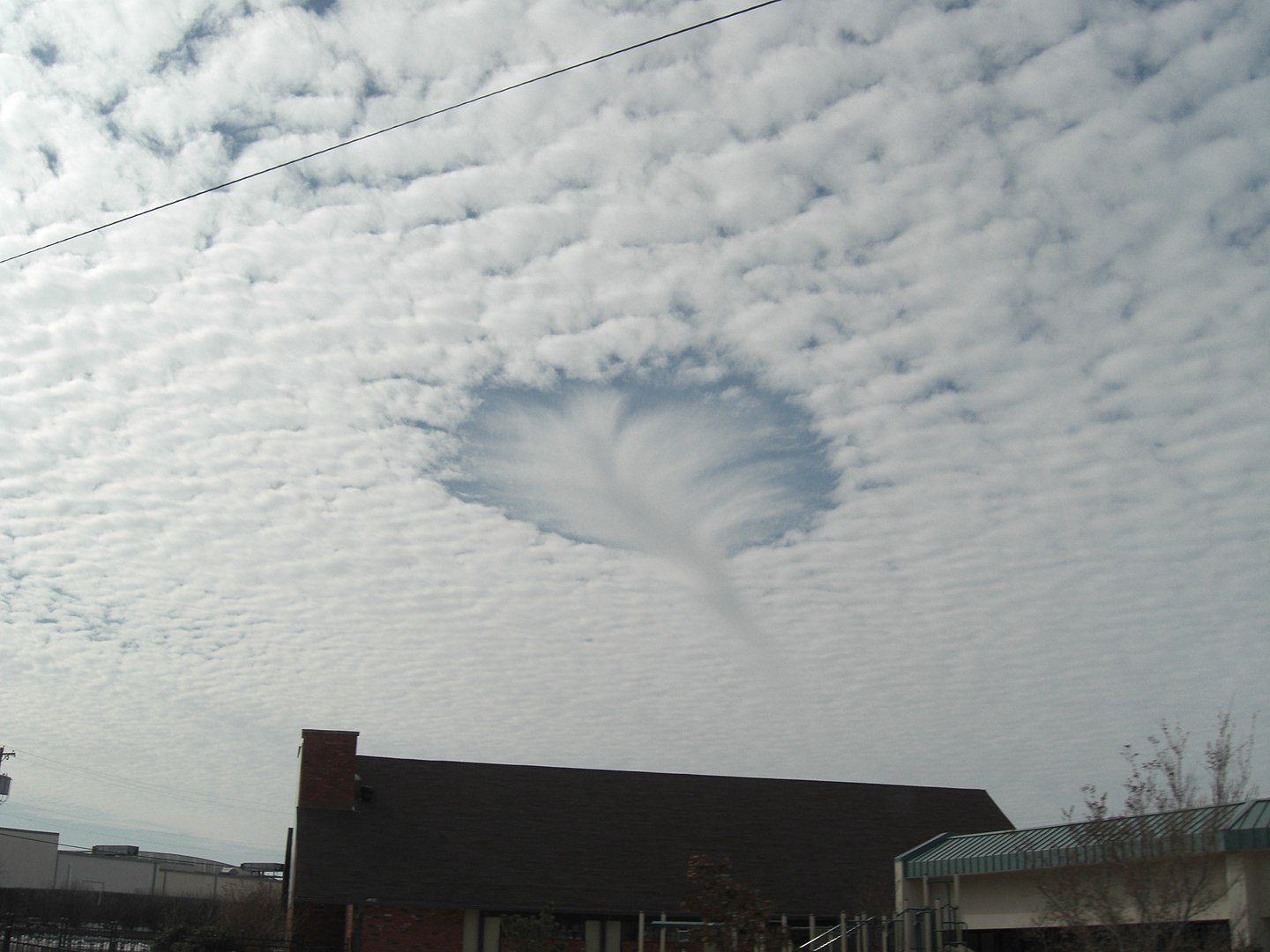
Have you ever gazed at the sky and noticed a peculiar hole in the clouds, known as a Fallstreak Hole Cloud? These fascinating meteorological phenomena have captured the attention of nature lovers and scientists alike. This blog post will uncover the mystery behind Fallstreak Hole Clouds and examine how weather conditions, supercooled water droplets, and aircraft activity contribute to their formation.
We’ll explore how stable weather conditions play an essential role in fallstreak hole formation and the significance of supercooled water droplets in creating these mysterious holes. Additionally, we will discuss aircraft’s impact on hole-punch clouds and their connection to rapid cooling processes triggered by aircraft passage.
Notable sightings and observations from satellite imagery to reports across Australia and around the world will be highlighted for your visual delight. Moreover, scientific studies focusing on jet exhaust and propeller force related to cloud transformation are also addressed within our comprehensive analysis.
Last but not least, we’ll examine various types of clouds involved in fallstreak hole formation, such as cirrocumulus and altocumulus clouds, while shedding light on intriguing occurrences like aircraft-induced snow showers. Finally, learn how observing Fallstreak Hole Clouds from airplanes can offer unique insights into this captivating phenomenon.
The Science Behind Fallstreak Holes
Have you ever taken a look up and seen an unusual hole in the sky’s clouds? These mysterious formations are known as fallstreak holes or sometimes referred to as punch hole clouds. They occur when supercooled water droplets within specific cloud layers freeze into heavier ice crystals and sink, leaving behind an intriguing gap amidst the surrounding clouds. Let’s dive deeper into this rare meteorological phenomenon.
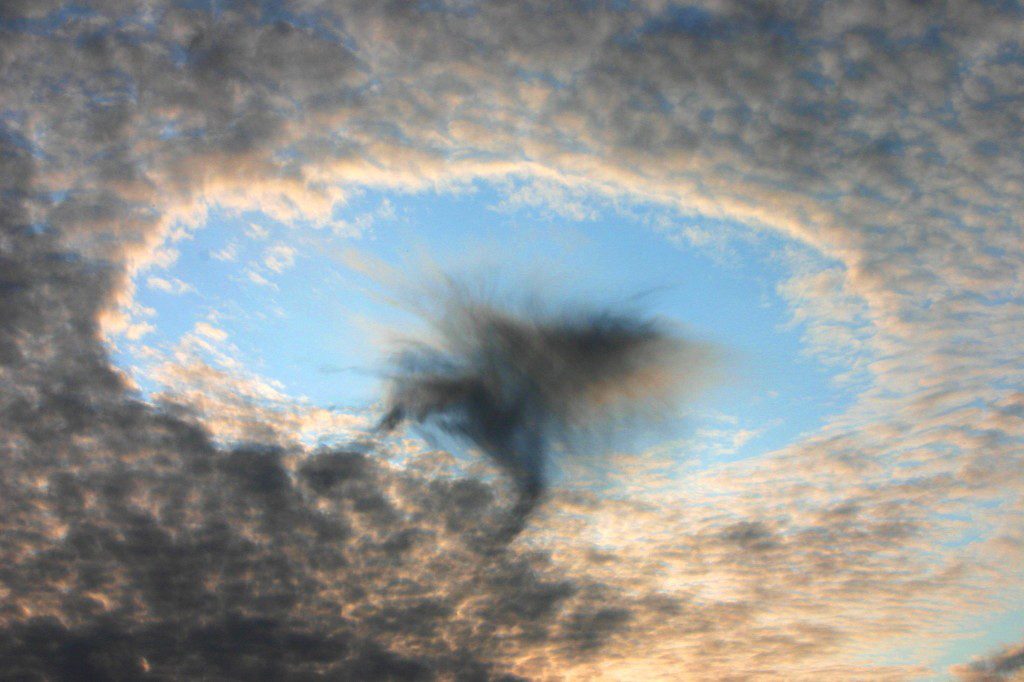
Formation Process of Fallstreak Holes
Fallstreak holes typically appear in altocumulus clouds or cirrocumulus clouds on stable days, with a blanket of mid-level clouds stretching miles overhead. The formation process begins when supercooled water droplets suddenly freeze due to external factors such as air pressure changes or contact with ice nuclei. As these newly formed ice crystals become heavier, they descend through the cloud layer, causing nearby supercooled droplets to evaporate.
Role of Supercooled Water Droplets
- Suspended State: Supercooled water droplets remain liquid even at temperatures below the freezing point because they lack impurities that would initiate crystallization.
- Rapid Freezing: When triggered by external factors like passing aircraft (more on that later), these suspended particles rapidly transform into a solid state – forming ice crystals.
- Cascading Effect: The presence of ice crystals causes neighboring supercooled droplets to evaporate, leading to the expansion of fallstreak holes over time until equilibrium is reached between evaporation and condensation processes within the cloud layer.
Now that we have a better understanding of the science behind these fascinating formations let’s explore how human activities – specifically air travel – can influence their creation.
The formation of fallstreak holes is a complex process that requires an understanding of the role supercooled water droplets play in their development. Moving on, aircraft have been known to trigger the transformation from cirrocumulus clouds into hole-punch clouds and cause fallstreak holes.
Aircraft’s Influence on Hole-Punch Clouds
Did you know that aircraft play an essential role in the formation of fallstreak holes? These magnificent sky phenomena are created when planes cause rapid cooling and evaporation processes within specific cloud layers containing supercooled water droplets. Let’s explore how these flying machines trigger such transformations.
How Planes Trigger the Transformation
When aircraft pass through mid-level clouds, their propellers and wings generate sufficient force to cause ice particles to form within these atmospheric strata. This sudden change leads to the eventual collapse of surrounding clouds into raindrops or snowflakes approximately 45 minutes later. The result? A stunning hole-punch cloud for all nature lovers to admire.
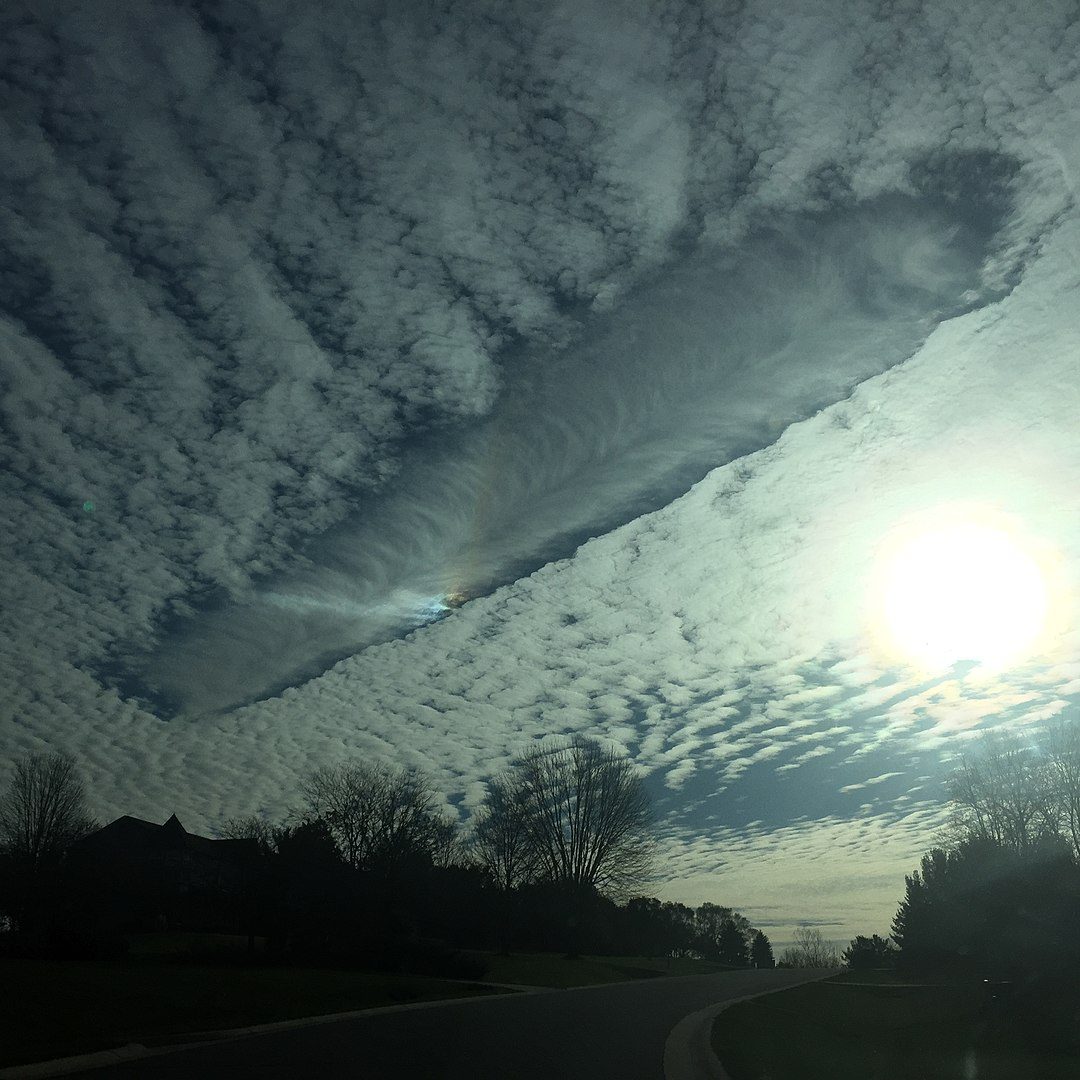
Examples of Aircraft-Induced Fallstreak Holes
- The Louisiana & Texas Phenomenon: On January 29th, 2007, NASA’s Terra satellite captured breathtaking images showing fallstreak holes over Louisiana and Texas. It was a rare sight indeed.
- Sightings in Florida & South Carolina: Residents across Central Florida have snapped photos capturing these bizarre disappearing clouds, with additional sightings reported in South Carolina.
- A Canadian Observation: Weather Network meteorologist Tyler Hamilton observed similar occurrences in Canada after reviewing flight data. He found instances where aircraft were responsible for creating mesmerizing hole-punch clouds.
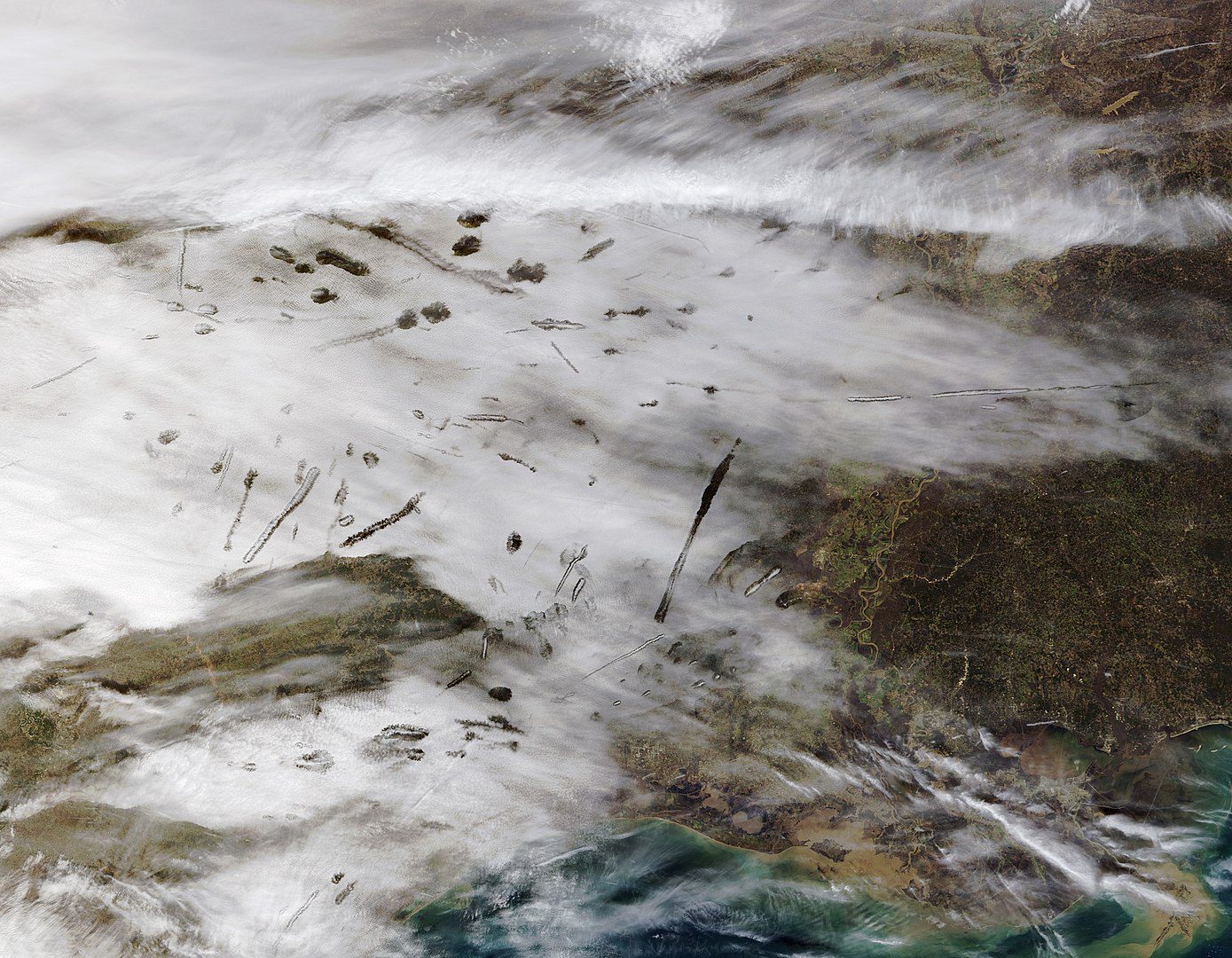
Intrigued by this unique interplay between aircraft and the atmosphere? Keep an eye out for these rare meteorological phenomena during your next flight or while observing the sky from below. You never know when you might witness a fallstreak hole in action.
Aircraft have a major influence on hole-punch clouds and can be used to trigger their transformation. Moving on, let’s explore the different types of hole-punch clouds and their characteristics.
Types and Characteristics of Hole-Punch Clouds
Fallstreak holes can occur within two common types of clouds – cirrocumulus and altocumulus. Both variations display similar characteristics; however, differences in appearance arise depending on factors such as altitude and temperature. Let’s delve into the fascinating world of these mysterious cloud formations.
Cirrocumulus Hole-Punch Clouds
Cirrocumulus clouds, characterized by thin white patches at high altitudes, are often found between 16,000 to 39,000 feet above Earth’s surface. Supercooled droplets of H2O that morph into ice crystals when temps dip below zero make up these mid-level clouds. When a fallstreak hole forms within cirrocumulus layers, it creates an awe-inspiring sight for nature lovers who happen to catch a glimpse.
Altocumulus Hole-Punch Clouds
In contrast to their higher-altitude counterparts, altocumulus clouds have more extensive coverage due to increased moisture content near Earth’s surface. Altoculumus clouds, situated between 6,500 and 20,000 feet above ground level and containing supercooled droplets, are a key factor in the formation of hole-punch clouds.
The heavier ice crystals formed during this phenomenon cause surrounding water droplets to evaporate rapidly or freeze instantly before falling from the sky like raindrops or snowflakes.
- Hole punch cloud sightings: Both cirrocumulus and altocumulus hole-punch clouds have been observed in various locations worldwide, leaving onlookers mesmerized by their peculiar appearance.
- Temperature fluctuations: The formation of fallstreak holes within these cloud types is heavily influenced by temperature changes that affect the behavior of supercooled water droplets and ice crystals.
Whether it’s a cirrocumulus or an altocumulus hole-punch cloud, witnessing this rare meteorological event is truly a breathtaking experience for all nature enthusiasts.
The characteristics of hole-punch clouds can vary greatly, depending on the type and formation. With this in mind, it is important to observe fallstreak holes around the world to gain a better understanding of their behavior. Next, we will explore observations and sightings from various locations across the globe.
Observations & Sightings Around the World
The enigmatic fallstreak holes have been spotted in various locations across the globe, capturing the attention of nature lovers and meteorologists alike. In a remarkable instance, on January 29, 2007, NASA’s Terra satellite captured images of these hole-punch clouds over Louisiana and Texas.
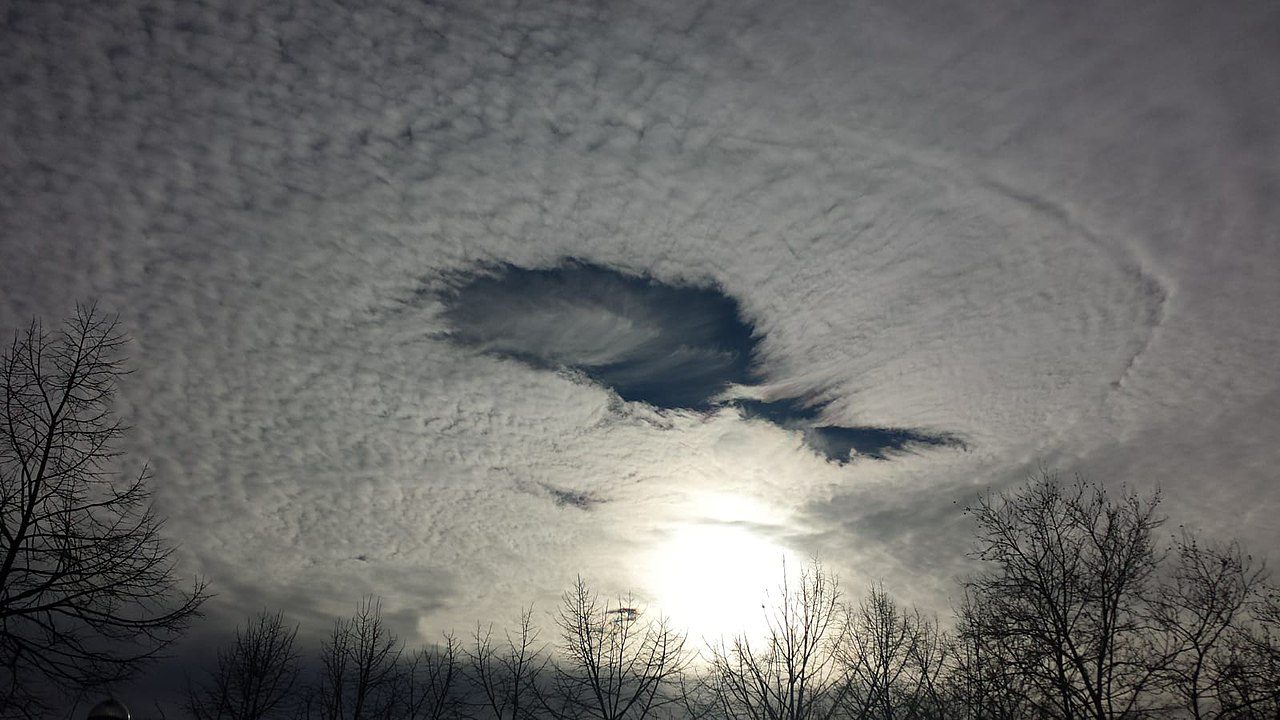
Fallstreak Holes Over Louisiana and Texas
In this particular event, aircraft-induced fallstreak holes were observed amidst an expansive layer of altocumulus clouds. The intriguing formations stood out as circular voids within the surrounding clouds, sparking curiosity among those who witnessed them.
Sightings in Florida, South Carolina, and Canada
- Florida: Residents all over Central Florida have documented their encounters with these mysterious disappearing clouds through photographs that showcase their peculiar beauty.
- South Carolina: Similar sightings have also been reported by individuals residing in South Carolina who were fortunate enough to observe this rare meteorological phenomenon firsthand.
- Canada: Weather Network meteorologist Tyler Hamilton was able to identify occurrences of fallstreak holes after reviewing flight data from Canadian airspace. This discovery further demonstrates how widespread these captivating cloud formations can be when conditions are just right for their development.
Aircraft-induced fallstreak holes provide a fascinating glimpse into the complex interplay between human activity and atmospheric processes. It is essential to both appreciate the amazing sights of nature and strive to comprehend their workings as we further explore our environment.
As the sightings of fallstreak holes around the world have shown, these mysterious clouds can be seen in a variety of places. Moving on to major airports, research has been conducted to study this phenomenon more closely.
Studying Hole-Punch Clouds at Major Airports
The bustling atmosphere of major airports provides an unparalleled opportunity to study the enigmatic hole-punch clouds. With countless planes passing through mid-level clouds, researchers can closely observe and analyze the formation process of these captivating meteorological phenomena. In this section, we will delve into why major airports are essential for research on fallstreak holes and discuss some intriguing findings from a recent study conducted by the National Center for Atmospheric Research (NCAR). Read PDF here.
Importance of Major Airports in Research
Airports with heavy air traffic serve as prime locations for studying fallstreak holes, as numerous aircraft continuously interact with cloud layers containing supercooled water droplets. These interactions lead to rapid transformations within the surrounding clouds, creating perfect conditions for fallstreak hole formations.
- Frequent airplane-cloud interactions: The constant presence of airplanes at busy airports allows scientists to monitor how different types and sizes of aircraft affect fallstreak hole formations.
- Diverse weather conditions: Studying fallstreak holes at various airports around the world exposes researchers to a wide range of atmospheric variables such as temperature, humidity, and wind patterns that may influence their development.
- Data collection opportunities: Airport-based studies enable researchers to collect valuable data about ice crystal formation processes within altocumulus and cirrocumulus clouds – crucial information needed to better understand this rare phenomenon.
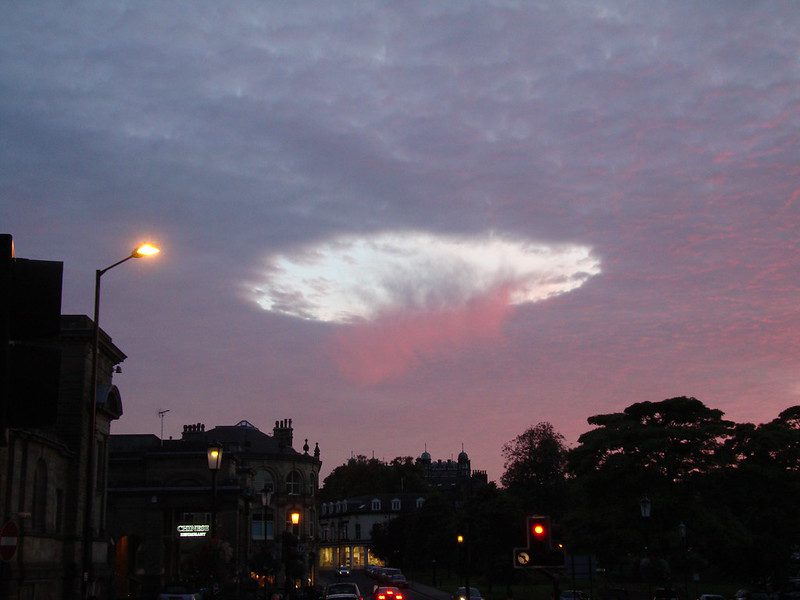
Findings from NCAR’s Study on Fallstreak Holes
In a pioneering research effort headed by Andrew Heymsfield from the National Center for Atmospheric Research (NCAR), it was determined that jet exhaust released by aircraft has an influential role in forming fallstreak holes.
As planes pass through cloud layers, their engines release warm air interacting with supercooled droplets, causing them to freeze into heavier ice crystals. These newly-formed ice particles then sink and evaporate, leaving behind the characteristic punch-hole shape within the surrounding clouds.
This fascinating research not only sheds light on how aircraft contribute to these captivating meteorological events but also highlights the importance of studying such phenomena at major airports worldwide.
By studying hole-punch clouds at major airports, NCAR has been able to gain valuable insights into the formation and development of these fascinating cloud formations. As a result, passengers can now observe fallstreak holes from airplane windows as aircraft wings impact cloud structures in unique ways.
Key Takeaway:
Major airports provide a unique opportunity to study fallstreak hole clouds due to the frequent interactions between aircraft and supercooled water droplets in mid-level clouds. Researchers can collect valuable data on ice crystal formation processes within altocumulus and cirrocumulus clouds, which is crucial for understanding this rare phenomenon. A recent National Center for Atmospheric Research study found that jet exhaust released by aircraft plays an influential role in forming these captivating meteorological events.
Fallstreak Hole Cloud – Witnessing Fallstreak Holes From Airplane Windows
Imagine gazing out of your airplane window and witnessing a rare meteorological phenomenon unfolding right before your eyes. This is precisely what some lucky passengers have experienced when observing fallstreak holes, also known as hole-punch clouds, during their flights.
How Passengers Can Observe Hole-Punch Clouds
To increase the chances of spotting these captivating formations, one should look for them in the vicinity of mid-level clouds such as altocumulus clouds. Look for these clouds in the range of 6.5k-20k ft (2k-6.1km) from ground level. Keep an eye on areas where surrounding clouds seem to vanish or display peculiar circular gaps – that’s where you might find a fallstreak hole.
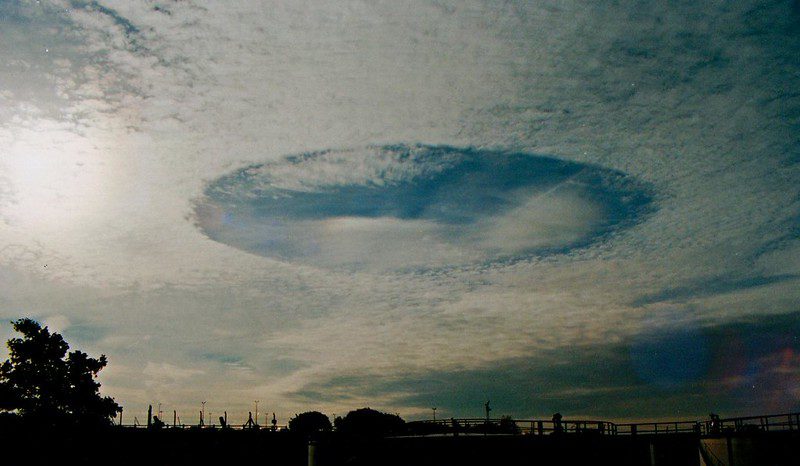
- Cirrocumulus: Thin white patches at high altitudes with small ripples or waves.
- Altocumulus: Larger cloud coverage due to increased moisture content near Earth’s surface.
The Impact of Aircraft Wings on Cloud Structures
Aircraft play a crucial role in the formation process by triggering rapid cooling and evaporation within specific cloud layers containing supercooled water droplets. As planes pass through these atmospheric strata, their propellers and wings generate sufficient force to cause ice particles to form within the cloud layer.
The heavier ice crystals then sink while attracting more water vapor from nearby supercooled droplets, which leads up to their eventual collapse into raindrops or snowflakes approximately 45 minutes later.
For a detailed explanation of this fascinating process, check out this Scientific American article that delves into the science behind hole-punch clouds. So next time you’re on a flight, don’t forget to look out your window and try to spot these mesmerizing fallstreak holes – an extraordinary display of nature’s wonders.
FAQs About The Fallstreak Hole Cloud
What Causes Fallstreak Holes in Clouds?
Fallstreak holes, also known as punch hole clouds, are caused by the interaction of supercooled water droplets with ice crystals. When a plane passes through a cloud layer containing these droplets, it can trigger the transformation of supercooled water into ice crystals. The newly formed ice particles then fall, leaving behind a visible hole in the cloud.
What Does It Mean When You See a Hole in the Clouds?
Seeing a hole in the clouds typically indicates that an aircraft has passed through that area and initiated the formation of fallstreak holes or hole-punch clouds. These unique meteorological phenomena occur due to changes in temperature and humidity caused by airplanes flying through certain types of cloud layers.
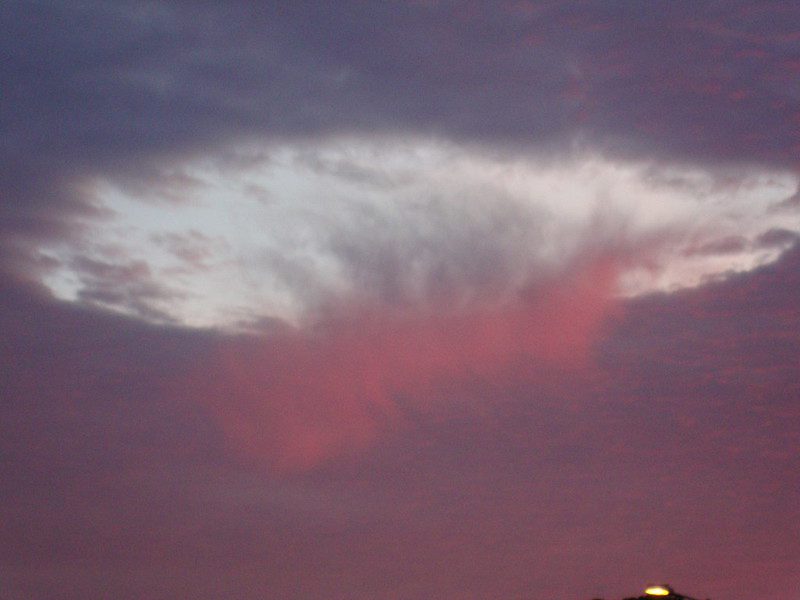
Are Hole Punch Clouds Rare?
Hole punch clouds are relatively uncommon but not extremely rare. They tend to form more frequently near major airports where there is significant air traffic passing through suitable cloud layers containing supercooled water droplets capable of forming these distinctive features.
Are Fallstreak Holes Rare?
While not exceedingly rare, fallstreak holes are considered unusual meteorological events. Their occurrence depends on specific atmospheric conditions such as temperature and humidity levels within certain types of cloud formations like cirrocumulus or altocumulus. Observations may be more frequent around areas with high air traffic volume.
Conclusion
Overall, Fallstreak Hole Clouds is a fascinating natural phenomenon that can be triggered by aircraft passing through altocumulus and cirrocumulus clouds. NASA’s Terra satellite imagery has captured stunning images of these formations in Louisiana, Texas, and Florida. It is important to note the differences between contrails and fall streaks, as well as the localized snow showers that can result from aircraft activity.
Scientific research has debunked paranormal theories surrounding Fallstreak Hole Clouds and instead focuses on the role of aircraft propellers and wings in their formation. In-flight observations have shown that cooling effects can cause ice crystal generation leading to these unique cloud formations. Overall, studying Fallstreak Hole Clouds provides valuable insights into atmospheric conditions and highlights the beauty of nature’s wonders.







































